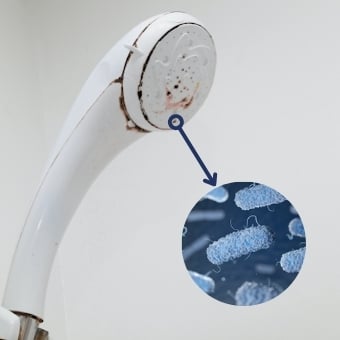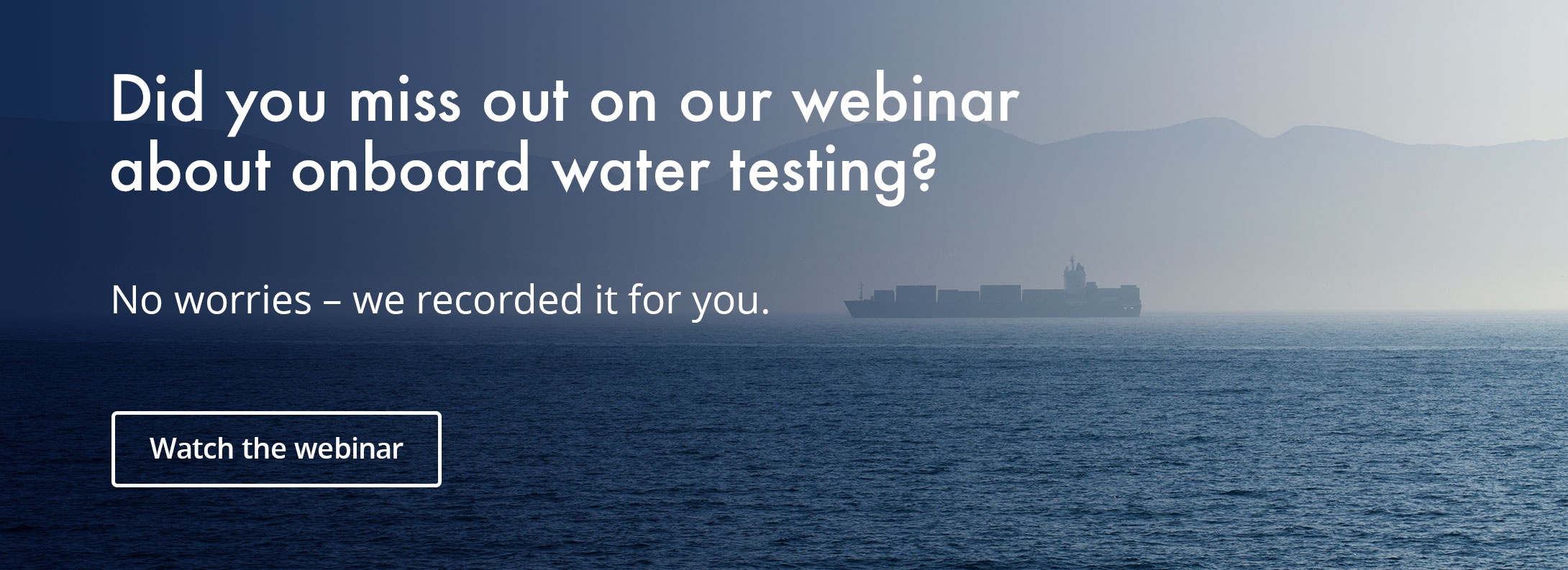Whether you suspect its presence or simply want to take precautions: Testing for Legionella is quick and easy.
Water systems on board ships and offshore installations can be ideal breeding grounds for Legionella pneumophila. An outbreak poses a serious health threat to your crew, and can derail an entire operation.
To increase confidence in your control of the bacterial pathogen, follow this procedure.
- Identify likely hotspots.
- Select the appropriate test kit
- Wait for indications from the speed tests.
- If positive, send the sample to a lab for confirmation, and consult your management for appropriate counter-measures. If negative, proceed as normal.
- Repeat as necessary.
Let’s elaborate on each step.
Where to test for legionella
Legionella thrives in stagnant water at temperatures between 20–50 degrees centigrade. Unclean surfaces also provide favourable conditions for Legionalla growth.
Typical hotspots to test for Legionella are:
- Unused/rarely used showerheads
- Water taps
- “Dead legs” in water distribution systems (little or no circulation)
- Pipe bends and other flow-restricting elements
- Pipe fittings and other rough, internal surfaces
 |
Unused showerheads are breeding grounds for Legionella.
|
Read more: Water Testing on Board Ships: How to Achieve Compliance
Selecting the appropriate test kit
We test for both waterborne and surface Legionella. Thus, you need two types of test kits: One for detecting in water, and one for biofilms on surfaces.
It is often a good idea to apply both methods to the same spot. For instance, 1) draw a water sample from a tap and 2) swab the inner surfaces of the same tap. Both test kits produce indicative results, and should be taken every bit as seriously as a confirmed laboratory test.
Industrial test kits: For water
Industrial test kits are suitable for testing water in distribution systems, cooling towers and water tanks. Testing the water is straightforward:
Connect the sample point to the water system. The system pressure will drive the water through a filter. Retrieve the filter and apply a solution (recovery buffer) to it.
Transfer the recovery buffer to the test strip. Leave to incubate at room temperature. The results will appear after approximately 30 minutes.
The test kit contains foil-wrapped tests, hollow-fibre filters, syringes containing recovery buffers, a filtrate collection bottle, and pipework adaptor with 1/2" and 3/4" female threaded connectors. It can also connect to a shower head thread.
Biofilm test kits: For surfaces
The biofilm test kit is a vital addition to the industrial test kit: Legionella bacteria can thrive in biofilms in showerheads, hot water tanks, swimming pools et cetera. Even if your water samples turn out clean, internal biofilms can harbour Legionella. Left undetected, the biofilm – with the Legionella colony – can grow and spread to other parts of the system.
The biofilm testing kit has two applications:
- Detect surface contamination
- Demonstrate cleanliness of an area after a targeted cleaning.
The biofilm test kit consists of swabs, reaction tubes, pipettes and test strips. Swab the surface in question, place it in a reaction tube and transfer the liquid to the test strip. Results appear after 20–25 minutes.
 |
The ever-busy Suez canal. Ships that operate in hot areas should be alert to Legionella on board.
|
What if the result is positive?
If you get a positive indication of Legionella presence, you have to immediately send the sample ashore for analysis at an accredited laboratory.
Isolate the exposed area. Contact your management for instructions.
When to test for Legionella
There are a few different factors that can influence the proliferation of Legionella on board.
- Time
- Changes in local climate
- Resuming from stacking
The time factor is important. A Legionella-free shower head might be contaminated over the next six months. We recommend that you perform regular tests of vulnerable spots, perhaps at 3–5 different locations. If you’re unsure where to test, consult with health professionals.
Local climate is another key consideration. If your vessel normally operates in Alaska, but gets chartered for operations on the coast of Africa, the temperature change can make dormant Legionella colonies flourish. If you’ve relocated to an area with unfavourable temperatures, adjust your testing regime accordingly.
Resuming from stacking can also pose a risk. If a ship, or sections of the ship, have been out of operation for some time, but are now coming back into operation, you should test for Legionella. Any amount of undrained, stagnant water is likely to contain microbial pathogens.
Testing for Legionella is an inexpensive and simple way to prevent outbreaks.
Would you like to learn more about preventing Legionella outbreaks on board? Please consult WHO’s “Guide to Ship Sanitation”, page 36–37.
|
Martin Bruusgaard AS is a renowned supplier of maritime safety equipment, including a wide range of water test kits. Worldwide distribution on short notice. Get in touch with us today for a free consultation! |


